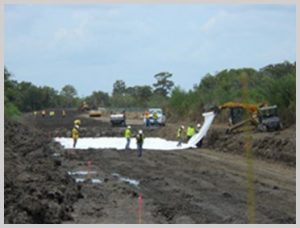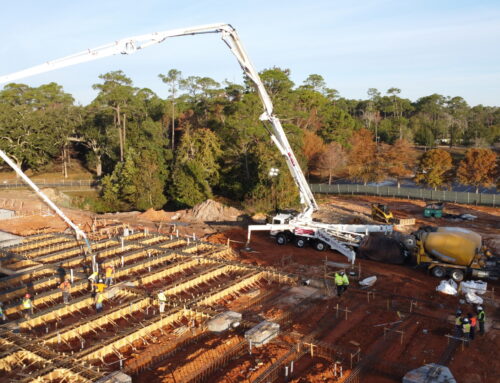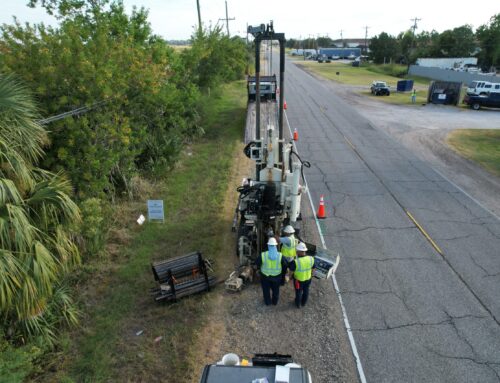OAKVILLE TO LAREUSSITE
 PLAQUEMINES PARISH, LOUISIANA
PLAQUEMINES PARISH, LOUISIANA
The NOV-NF-W-04 project planned to construct new levees and T-wall transitions paralleling LA Highway 23 from Oakville, Louisiana, to the LaReussite Siphon in Plaquemines Parish, Louisiana. This $45 million U.S. Army Corps of Engineers project would replace the existing non-federal levees with a new flood protection system that is designed and constructed in compliance with the requirements of the Hurricane and Storm Damage Risk Reduction System (HSDRRS) Design Guidelines. The 8.1-mile section of non-federal earthen levee between Oakville and LaReussite would be raised to an elevation between 8.5 and 12.25 feet in Plaquemines Parish. Concrete T-walls consisting of steel sheetpiles and steel H-piling would be installed, and compacted fill embankment and concrete slope pavement would be placed. A high-strength geotextile would be installed on the levees.
Beginning in July 2010, Eustis Engineering divided this levee system into five soil sub-reaches to account for the variations in the soil stratigraphy, strengths, and unit weight properties. Typical stratigraphy profiles, strength lines, and unit weight charts were developed for each sub-reach by evaluating over 80 undisturbed soil borings and the results of 200 cone penetration tests (CPTs). These data were acquired by others; however, additional borings were required in 2011 for design of the levee/T-wall tie-ins at the northern and southern ends of the project. Eustis Engineering obtained 5-in. diameter soil borings through FFEB JV, L.L.C., using a track-mounted drill rig, fixed piston sampling and wet rotary drilling techniques. Eustis Engineering’s designs for each sub-reach accounted for the varying soil parameters and provided the necessary safety factors for levee stability and seepage prevention. The levees were designed for construction using high strength geotextile reinforcement to minimize the footprint and placement towards the flood side of the existing levees.
Eustis Engineering performed the geotechnical analyses and engineering for this project that included design phase services for the earthen levee raise, the north and south T-walls, the T-wall fronting protection system at the Ollie Pump Station, and five complicated transitions between levees and pile supported T-walls. The original feasibility study efforts centered around evaluation of single and multiple stages of levee construction, two levee crown/floodwall elevations, and the use of prefabricated vertical drains (wicks) to accelerate consolidation settlement beneath levee enlargements. The option without wicks was chosen by the USACE for development of final plans and specifications.
Eustis Engineering performed the following analyses:
• global stability using Spencer’s Method and the Method of Planes for geosynthetic-reinforced levees and pile supported T-walls,
• gain-in-shear strength due to staged levee construction with and without wicks,
• time-rate of settlement,
• seepage for levees and walls,
• local and global stability of I-walls (including gap analysis),
• axial pile load capacity, lateral pile load-deflection, and
• downdrag settlement of piles due to fill placement.
Eustis Engineering developed design parameters for the geosynthetic-reinforced levee, T-wall fronting protection, T-wall siphon monoliths, and levee/T-wall tie-ins in accordance with the HSDRRS design guidelines. Eustis Engineering recommended the levee/floodwall tie-in locations be preloaded where concrete scour protection is planned and surcharged where the T-wall/I-wall/levee transition occurs. This required additional time-rate of settlement analysis to define the preload/surcharge geometry and duration. The purpose of the surcharge/preload sites was to induce settlement in the foundation soils prior to the construction of the permanent flood protection features.
Because of the three-dimensional nature of the loading due to fill placement at these locations, evaluations of settlement using three-dimensional modeling were required. Eustis Engineering also evaluated the potential for excessive bending moment in piles due to downdrag loading. During the course of the feasibility and final designs, Eustis Engineering conducted a design quality control plan that included internal control checks through two levels of review and external control checks through the ITR and the USACE’s DrChecks computer system.
Eustis Engineering provided engineering during construction services for the project, which included review of RFIs and contractor submittals as well as site visits. Eustis Engineering’s services also included a review of the test pile program and an evaluation of the results of dynamic pile testing that was required to assess the integrity of a suspect concrete pile.
Eustis Engineering was heavily involved in the final preparation of the geotechnical instrumentation plan as well as installing instrumentation devices and obtaining and evaluating the readings from these devices. These devices included vibrating wire (VW) piezometers, VW settlement gauges, inclinometers, settlement plates and dataloggers which allowed for remote sensing using web-based applications. Eustis Engineering worked closely with the USACE and contractor to install this instrumentation without interrupting their construction sequence.
The instrumentation program was extensive because of the length of the levee and the number of preload/surcharge stacks. Instrumentation devices were required on a 1,000-ft spacing for a substantial portion of the 8.1-mile levee. Eustis Engineering acquired, installed, monitored, and interpreted data from 29 sets of piezometers, settlement plates and dataloggers for the levee in addition to a suite of piezometers, settlement gauges and plates, inclinometers and dataloggers for five preload/surcharge areas where a floodwall was planned to tie into a levee. Eustis Engineering used their drill rigs, CPT rigs, and excavators to install the devices which required close coordination with the construction contractor and the USACE to avoid disruption of construction activities.
Eustis Engineering prepared bi-weekly instrumentation reports throughout the preloading periods of the levee/T-wall tie-ins and during the Stage 1 holding period for the levees. These reports were evaluation reports that included photos and documentation of our observations and interpretations of the instrumentation data. From these data, Eustis Engineering was able to determine when the preloads were considered substantially complete, and this information was vetted with the Vicksburg District who was overseeing the engineering with this project. We also successfully worked in tandem with the New Orleans District who was overseeing the construction of the project. Eustis Engineering provided these services to aid in achieving a successful project for the USACE and Plaquemines Parish. Eustis Engineering also provided an intermediate assessment of progress and a final report to the USACE.
Eustis Engineering employees logged more than 10,700 hours on this project.




